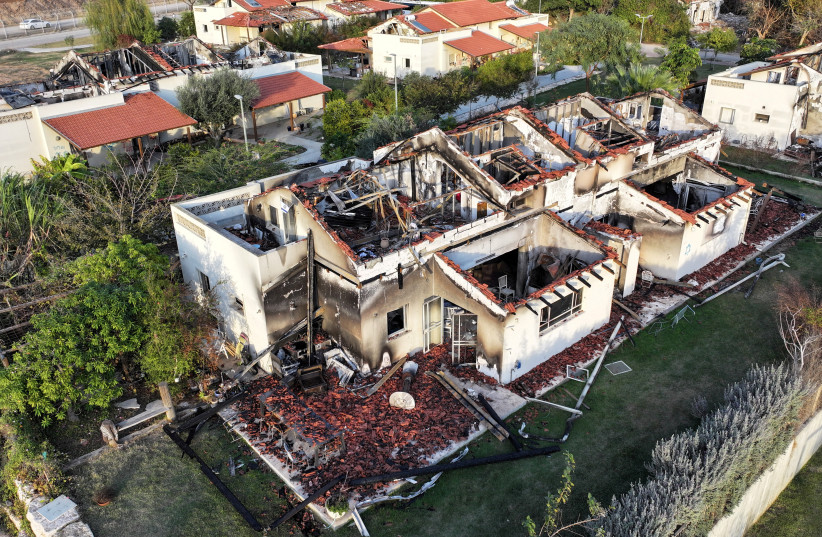The events of the October 7 massacre led to the evacuation of Israeli communities on the borders of Gaza and Lebanon, creating an unprecedented challenge to border towns. These towns have two main aspects – community and land. The connection between a certain ecology and a group of people that chose it, together create the town, the kibbutz or the moshav. When the ground is dropped – literally – from under the community’s feet, the town might be rattled to its core, especially when there is no clear future horizon of return.
The connection between man and the earth is examined here at a transformative intersection.
This is a critical time for these towns, when the communities have been uprooted from their land. Will the residents remain resilient as a community while they are cut off from their common streets and parks, and will families return to their homes? Will education return to function as it did before October 7? Will the internal mechanisms of the community survive the upheaval and continue to exist? These questions all have one result, one that is yet to be determined: will the residents choose to return to their homes and rebuild their lives?
The realities of evacuees from north to south
In the Gaza Envelope, or western Negev, where the kibbutzim and moshavim are no more than four kilometers from the Gaza Strip, the challenge is obvious: they require significant physical rehabilitation. Another challenge facing the communities is the ongoing trauma of the hostages who have not yet returned, and of course – the terrible massacre that took place that took many lives with unimaginable cruelty.
On the other hand, the surrounding towns that are further away from the border, within a range of four to seven kilometers, are slowly returning to their homes and with great effort, when recently the Home Front Command even announced the possibility of returning to some kind of school routine.
On the northern border, due to the ongoing fighting in Lebanon, the situation is even more complex. Residents have been evacuated to hotels for over four months. No one was kidnapped, and there was no massacre, but what will become of the communities? The efforts to preserve the education systems on the part of the regional councils are endless, in an attempt to give the children and their parents a little stability in conditions of continuous uncertainty.

The need for community resilience
To ensure the return of the communities to their homes, they need to remain as communities. The tools required here are not only tractors, tanks, and machine guns; soft communal tools are also needed.
The latest international research on community resilience emphasizes the importance of the existence of networks of relationships between community members; between a single community to corresponding communities; and between it and external institutions.
The tighter, closer, and more intense the ties, the greater the chance for a community to survive an acute crisis.
We have the power to strengthen the affected communities at this complex time by strengthening the educational, cultural, and welfare systems that exist within them. Groups of regular volunteers, who participate in these systems on an ongoing basis, can be a foundation on which connections can be maintained. Young people have enormous power to make a difference at this time. We need government support to show the power of “soft” civil organizations to bring about change.
Investing in social networks will strengthen the community's resiliency. Firstly, invest in intra-community ties, anchoring gatherings and meetings between different segments of the population – the children, young groups, families, and the elderly. Secondly, strengthen the ties between the displaced communities, forming a wider community of people who are going through the same experiences. Thirdly, strengthen the connections between the community and external parties: civil society parties, government officials, and regional councils, that can give them external support.
Trust as the key component
Another important point for strengthening community resilience is the issue of trust. The trust that the leadership will be able to create during the crisis will stem from the ability to communicate the objective challenges to the community and the mobilization of community members to create adapted solutions. The trust and the sense of belonging that arises from community processes in which the community members are partners are the ones capable of creating a significant change in the connections within the community that in the end will directly affect its ability to survive.
An example can be taken from communities that experienced the tsunami in Japan. Studies that examined communities with identical characteristics that did or did not last after the disaster, showed that precisely a community where there was an extraordinary government investment in a new, magnificent bridge fell apart. Since the process of building the bridge was done bureaucratically “over the heads” of the community, it created a feeling of alienation between the members of the community and their settlement and eventually caused the settlement to be abandoned.
Therefore, the resilience-strengthening processes for the displaced communities will only be effective if they are smart, soft, and sensitive.
The writer is the head of Kedma – Young Settlements, an organization that operates youth villages and student villages in towns and kibbutzim near the northern border.
